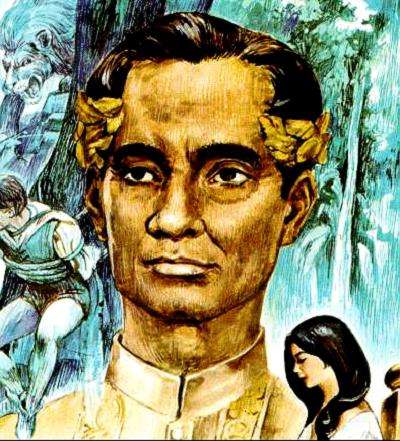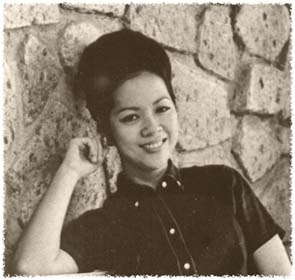“The
Filipino Writers “

1. NICK JOAQUIN
Nick
Joaquín was born in Paco, Manila, one of the ten children of Leocadio, a
colonel under General Emilio Aguinaldo in the 1896 Revolution, and Salome
Marquez, a teacher of English and Spanish., Joaquin taught himself by reading
widely at the National Library of the Philippines and the library of his
father, who by that time was a successful lawyer after the revolution. This
developed further his interest in writing.
At age 17, Joaquín was first published in the literary section of
the Pre-World War II Tribune under writer and editor Serafín Lanot. Before
publishing in the Tribune, Joaquin worked as a proofreader of the paper.
After
winning a Dominican Order-sponsored nationwide essay competition for La Naval
de Manila, the University of Santo Tomas awarded Joaquín an honorary Associate
in Arts (A.A.) and a scholarship to St. Albert’s Convent, the Dominican
monastery in Hong Kong. Upon his return to the Philippines, he joined the
Philippines Free Press, starting as a proofreader. Soon, he was noticed for his
poems, stories and plays, as well as his journalism under the pen name Quijano
de Manila. His journalism was markedly both intellectual and provocative,
Joaquín deeply admired José Rizal, Joaquín paid tribute to Rizal by way of
books such as The Storyteller’s New Medium – Rizal in Saga, The Complete Poems
and Plays of Jose Rizal, and A Question of Heroes: Essays in Criticism on Ten
Key Figures of Philippine History. He also translated the hero’s valedictory
poem, in the original Spanish “Mi Ultimo Adios,” as “Land That I Love,
Farewell!”
The contributions of Nick Joaquin in Philipine poetry
His contributions are:
He
translated Noli Me Tangere
He wrote a Philippine poet which sold millions
He helped the Filipinos because he is knowledgeable.
Examples of the Short Story Of Nick Joaquin.
- Manila, My Manila: A History for the Young (Maynila, Aking Maynila: Isang Kasaysayan ukol sa Bata) (1990),
- Cave and Shadows (Ang Yungib at mga Anino) (1983
- Prose and Poems (Mga Tuluyan at Patula) (1952)
- The Woman Who had Two Navels (Ang Babae na may Dalawang Pusod) (1961)
- La Naval de Manila and Other Essays (La Naval de Manila at Iba pang Sanaysay) (1964)
- A Portrait of the Artist as Filipino (Ang Larawan ng Artista bilang Pilipino) (1966)
- Tropical Gothic (Gotikong Tropikal) (1972)
- The Complete Poems and Plays of Jose Rizal (Ang mga Kumpletong Tula at Dulaan ni Jose Rizal) (1976)
- A Question of Heroes (Isang Tanong ng mga Bayani) (1977)
- Nora Aunor & Other Profiles (Si Nora Aunor & Iba pang Katangian) (1977)
- Ronnie Poe & Other Silhouettes (Ronnie Poe & Iba pang Aninag ng Bagay (1977)
- Reportage on Lovers (Pagbabalita sa Pag-ibig) (1977)
- Reportage on Crime (Pagbabalita sa Krimen) (1977)
- Amalia Fuentes & Other Etchings (Si Amalia Fuentes & Iba pang Pag-uukit sa Bakal) (1977)
- Gloria Diaz & Other Delineations (Si Gloria Diaz & Iba pang Delinasyon) (1977)
- Doveglion & Other Cameos (Si Doveglion & Iba pang mga Kameo) (1977)
- Manila: Sin City and Other Chronicles (Maynila: Makasalanang Lungsod at Iba pang Kronika (1977)
- Tropical Baroque (Tropikal na Baroque) (1979),
- Stories for Groovy Kids (Mga Kuwento para sa mga Batang Kasiya-siya) (1979)
- Language of the Street and Other Essays (Ang Wika ng mga Kalsada at Iba pang mga Sanaysay) (1980)
- The Ballad of the Five Battles (Ang Kurido ng mga Limang Labanan) (1981)
- The Aquinos of Tarlac: An Essay on History as Three Generations (Ang mga Aquino sa Tarlak: Isang Sanaysay sa Kasaysayan bilang Tatlong Salinlahi) (1983)
- Almanac for Manileños (Almanak para sa mga Taga-Maynila)
- Cave and Shadows (Ang Yungib at mga Anino) (1983)
- The Quartet of the Tiger Moon: Scenes from the People Power Apocalypse (Ang Apatang Pangkat ng Tigreng Buwan: Mga Tagpo ng Apokalipsis ng Lakas Sambayanan) (1986)
- Collected Verse (Nilikom na Panulaan (1987)
- Culture and History: Occasional Notes on the Process of Philippine Becoming (Kultura at Kasaysayan: Mga Madalang na Tala sa Proseso ng Pagiging Pilipinas) (1988)
- Manila, My Manila: A History for the Young (Maynila, Aking Maynila: Isang Kasaysayan ukol sa Bata) (1990),
- The D.M. Guevara Story (Ang Kuwento ni D.M. Guevara) (1993),
- Mr. F.E.U., the Culture Hero That Was Nicanor Reyes (G. F.E.U., ang Bayaning Kultura na si Nicanor Reyes) (1995).
- Rizal in Saga (Rizal sa Maalamat na Tuluyan) (1996)

2. FRANCISCO BALAGTAS
Francisco
Baltazar, known much more widely through his nom-de-plume Francisco
Balagtas, was a prominent Filipino poet, and is widely considered as the
Tagalog equivalent of William Shakespeare for his impact on Filipino
literature. The famous epic, Florante at Laura, is regarded as his defining
work.
Balagtas
learned to write poetry from José de la Cruz (Huseng Sisiw), one of the most
famous poets of Tondo. It was de la Cruz himself who personally challenged
Balagtas to improve his writing. (source: Talambuhay ng mga Bayani, for Grade 5
textbook)
In 1835,
Balagtas moved to Pandacan, where he met María Asunción Rivera, who would
effectively serve as the muse for his future works. She is referenced in
Florante at Laura as ‘Celia’ and ‘MAR’.
Balagtas’
affections for Celia were challenged by the influential Mariano Capule. Capule
won the battle for Celia when he used his wealth to get Balagtas imprisoned
under the accusation that he ordered a servant girl’s head be shaved. It was
here that he wrote Florante at Laura—In fact, the events of this poem were
meant to parallel his own situation.
He wrote
his poems in Tagalog, during an age when Filipino writing was predominantly
written in Spanish.
Balagtas
published Florante at Laura upon his release in 1838. He moved to Balanga,
Bataan in 1840 where he served as the assistant to the Justice of peace and
later, in 1856, as the Major Lieutenant. He was also appointed as the
translator of the court.

3. Bienvenido Santos
Bienvenido N. Santos
(1911–1996) he was a Filipino-American fiction, poetry and nonfiction
writer. He was born and raised in Tondo,
Manila. His
family roots are originally from Lubao,
Pampanga, Philippines. He lived in the United
States for many years where he is widely credited as a pioneering
Asian-American writer.
In 1967, he returned to the United States to become a teacher and university administrator. He received a Rockefeller fellowship at the Writers Workshop of the University of Iowa where he later taught as a Fulbright exchange professor. Santos has also received a Guggenheim Foundation fellowship, a Republic Cultural Heritage Award in Literature as well as several Palanca Awards for his short stories. Scent of Apples won a 1980 American Book Award from the Before Columbus Foundation.
Santos received honorary doctorate degrees in humanities and letters from the University of the Philippines, and Bicol University (Legazpi City, Albay) in 1981. He was also a Professor of Creative Writing and Distinguished Writer in Residence at the Wichita State University from 1973 to 1982, at which time the university awarded him an honorary doctorate degree in humane letters. After his retirement, Santos became Visiting Writer and Artist at De La Salle University in Manila; the university honored Santos by renaming its creative writing center after him.
"His Works"
The Novels
- The Volcano (1965)
- Villa Magdalena (1965)
- The Praying Man (1982)
- The Man Who (Thought He) Looked Like Robert Taylor (1983)
- What the Hell for You Left Your Heart in San Francisco? (1987)
The Short story collections
- You Lovely People (1955)
- Brother, My Brother (1960)
- The Day the Dancers Came (1967, 1991)
- Scent of Apples (1979)
- Dwell in the Wilderness (1985)
The Poetry
- The Wounded Stag (1956,1992)
- Distances: In Time (1983)

4.Gilda Cordero-Fernando
Gilda
Cordero-Fernando is a multiawarded
writer, publisher and cultural icon from the Philippines. She was born in Manila, has a B.A. from St.
Theresa's College-Manila, and an M.A.
from the Ateneo de Manila
University.
She was born on June 4, 1932.
Cordero-Fernando
has two landmark collection of short stories: The Butcher, The Baker and The
Candlestick Maker (1962) and A Wilderness of Sweets (1973). These
books have been compiled and reissued later as Story Collection (1994).
Another book, Philippine Food and Life, was published in 1992. Together
with Alfredo
Roces, Cordero-Fernando worked on Filipino
Heritage, a 10-volume study on Philippine history and culture
published by Lahing Pilipino in 1978. Afterwards, she founded GCF
Books which published a dozen titles that deal with various aspects of
Philippine culture and society. Cordero-Fernando has also worn numerous other
hats as a visual artist, fashion designer, playwright, art curator and
producer. In February 2000, she produced a hugely successful extravaganza
entitled Luna: An Aswang Romance....
Cordero-Fernando has also worn
numerous other hats as a visual artist, fashion designer, playwright, art
curator and producer. In February 2000, she produced Luna: An Aswang Romance.
In 2001 she produced Pinoy Pop Culture, the book and the show, for Bench.
In 1994, she received a Cultural Center of the Philippines (Gawad CCP) for her lifetime achievements in literature and publishing.
In 1994, she received a Cultural Center of the Philippines (Gawad CCP) for her lifetime achievements in literature and publishing.
This list of Filipino Writers
Francisco Arcellana
Lualhati Bautista
Carlos Bulosan
Cecilia Manguerra Brainard
Linda Ty Casper
Ingrid Chua-Go
Zoilo Galang
N. V. M. Gonzalez
Jessica Hagedorn
F. Sionil José
José Rizal
Alejandro R. Roces
Edilberto K. Tiempo
Kerima Polotan Tuvera
“My Reflection”
I am very thankful to the Filipino
writers who wrote a lot of different stories, with different Genre, the
Filipino writers expresses their real feelings in their writing that’s why when we read their works it inspires
us a lot and it helps us to understand what they are trying to imply to
the Filipinos ., the Filipino writers they are not only explaining or expanding
what happened in Spanish time when that the time we are in the hands of the
Spaniards, the maltreated works from
Spain to us and even the Americans, and Japanese , but in their writings they
given a lot of values that would connect in touch to our life, and would
connect also during the time of the Spaniards to the Filipinos, the works of
the writers serves as a mirror that would reflect our personality in their
writings that until now we still read, and it marks in our heart they thought
and deeds to us....
I
Walang komento:
Mag-post ng isang Komento